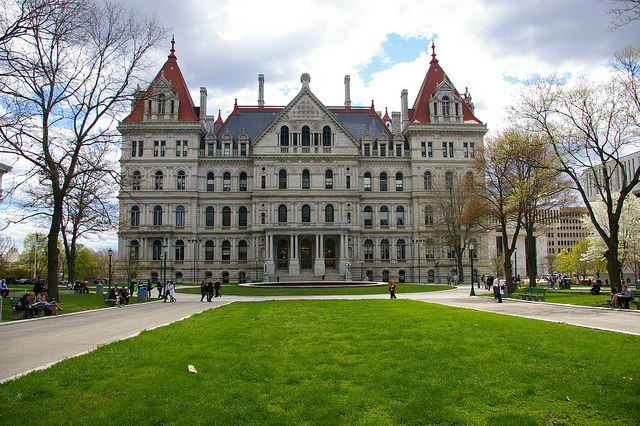Speed cameras weren't the only issue Albany failed to act on this session.
Back in February we asked safe streets and transit advocates what they wanted to see state legislators get done in 2017. Rationalizing bridge tolls to reduce traffic in the Manhattan core and fund transit, advancing policy to make streets less dangerous for walking and biking, and lifting the retrograde ban on electric-assisted bikes all made the list. Lawmakers delivered on none of those initiatives.
Here's our recap of Albany's 2017 session. Read it and weep.
Toll reform
With transit infrastructure in a state of overt collapse and NYC choking on increased traffic, you’d think the only plan around to deal with both problems at once would have been the talk of Albany this year. But if that's what you'd think, of course, you don't know Albany.
In 2016, Assembly Member Robert Rodriguez introduced enabling legislation for the Move NY toll reform plan. The bill got dozens of sponsors in the Assembly, but no companion bill surfaced in the Senate. That momentum didn't carry over to the 2017 session, when there was no action to speak of in either house.
Instead, Governor Cuomo, who has never lifted a finger to support Move NY, spent the session denying responsibility for the transit system he runs, while Assembly Speaker Carl Heastie -- who represents the Bronx, where 58 percent of households are car-free -- said he hoped he wouldn't be spending his summer "dealing with problems at the MTA.” Too bad straphangers won't have a choice.
E-bikes
Albany still didn't manage to fix New York's dated prohibition on electric-assist bicycles, which is out of sync with federal law.
Legislation sponsored by Senator Martin Dilan and Assembly transportation chair David Gantt this year would have legalized e-bikes, limiting top speeds to 20 mph and requiring users to wear helmets. But Gantt failed to move the bill out of his own committee, and the Senate transportation committee held up Dilan's version.
In NYC, that means NYPD and City Council members may continue to make a show of targeting working cyclists who need e-bikes to support themselves.
Unlicensed driving
As in 2016, the Senate passed a bill to strengthen penalties against unlicensed drivers who harm people, and the Assembly did not. Senate legislation from perennial sponsor Michael Gianaris would have made it a class E felony to cause serious injury or death while driving without a valid license, as long as the license was suspended or revoked for traffic offenses. But protecting New Yorkers from people who break the law just by getting behind the wheel was also not a priority for Carl Heastie.
Hit-and-run
Under current state law, relatively weak hit-and-run penalties give motorists an incentive to flee after a serious crash. Taking away that incentive has been a priority of prosecutors across the state for years. The Senate and Assembly pulled off a minor miracle in 2016 by passing legislation to change hit-and-run laws -- but that bill would have only made things worse, and district attorneys and safety advocates had to lobby Cuomo to veto it.
Marty Golden sponsored a bill this year to elevate the charge for leaving the scene of a crash with serious injury from a class E to a class D felony, and the charge for a fatal hit-and-run from a class D felony to class C -- class E being New York’s least severe felony category. It's the fix district attorneys have been waiting for.
But there was no miracle in 2017. Neither Golden’s bill nor its Assembly companion made it out of their respective transportation committees. A bill to establish an Amber Alert-type system to help the public identify and report hit-and-run drivers also stalled in committee in the Assembly and the Senate.
Drugged driving
Another priority of DAs this year was changing state code in response to a decade-old Court of Appeals decision. The ruling keeps police and prosecutors from charging people for driving under the influence of drugs that aren’t included on a state list of prohibited substances -- synthetic marijuana, for example -- even after a crash.
Though Cuomo cited drugged driving reforms as a goal in his 2017 State of the State book (page 350), they went nowhere.
Three-foot passing law
Upstate Senator Tom O’Mara sought to establish a three-foot buffer between cyclists and passing motorists, bringing clarity to the current standard of passing “at a safe distance.” The bill would have also made a sideswipe collision prima facie evidence of a driver’s failure to comply.
But lawmakers failed to give police a tool to charge drivers in crashes like the ones that killed NYC cyclists Dan Hanegby and James Gregg. O'Mara's bill stalled in committee in both houses.
Driver education
The Senate and Assembly passed legislation in 2016 to add a “bicycle and pedestrian safety component” to the state’s driver education curriculum, but it never reached Cuomo’s desk because lawmakers failed to reconcile the language of the bills. Marty Golden re-introduced the bill this year, but it only made it as far as the Senate transportation committee, and there was no companion Assembly bill.





